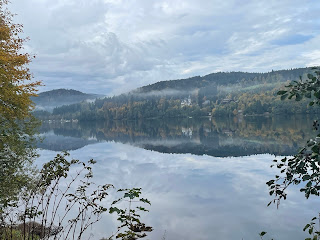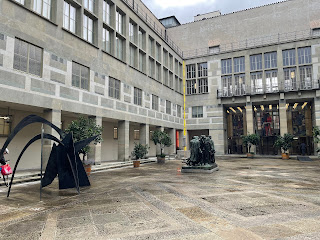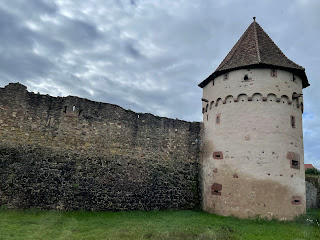The original plan was to spend today visiting a sort of "living history farm" outdoor museum of life in the Black Forrest region a century or two ago. But as we looked into it, we discovered that the rail connections there were (to put it charitably) somewhat Byzantine. The trip would take at least three hours (it's only an hour away by car), and it was unclear if and how we would get back.
Instead, we opted to just sleep in and then jump on a train to Basel, Switzerland which is less than an hour south of here. Basel was pretty sleepy on a Sunday morning -- not quite as empty as Freiburg yesterday, but close.
The walk from the rail station was through a pleasant park. Our first stop was the Elisabethenkirche (St. Elisabeth Church), which we expected to be busy on a Sunday morning. Indeed, the coffee shop was busy, but the church itself was totally empty -- no pews, no people, just some stained glass and an organ.
On we walked, to the nearby Kunstmuseum. This renowned museum of fine art has been around since 1671, making it the world's oldest art museum. But the building in which it currently resides is much newer and very, very large. It might have taken a full day to see everything there, and the admission fee is quite expensive. So we just looked at some sculptures in the courtyard and called it good.
Next up was Basel Munster, built in 1363 after a previous church was destroyed by an earthquake. This enormous church would have been the Roman Catholic cathedral, but the Reformation changed that.
Some precious art objects were destroyed, the monks were run out of the cloister, and the place was stripped pretty bare. We had to wait for a surprisingly well-attended worship service to end before we could enter. At least we got to hear some good organ music as we waited.
From Muster Platz we walked down hill to the Marktplatz, which is dominated by the Rathaus, or town hall.
(Wouldn't it be appropriate if all buildings where politicians work were called a Rat House?) This one is pretty grand and was started in 1504 with some later additions.
The decoration was done by artist Hans Holbein, who later became Court Artist to Henry VIII of England. The Baroque style is quite stunning, and we didn't even get inside on a Sunday.
We continued up Basel's main shopping street, Freie Strasse, but none of the exclusive and high-end shops were open on Sunday. Just as well, for us.
Our walk concluded at the Tinguely Brunnen Fountain, which is considerably newer than most things we saw. It was constructed in 1977 and has been moving and squirting constantly ever since.
 |
| Middle Bridge, first constructed in 13th century, made Basel a trade center. |
As we were pondering where to go next, two different Basel residents stopped and asked us (in perfect English) if we needed help finding our way. There are very kind and friendly people here! We finally decided to search for lunch and quickly found a crowded little sandwich shop for a bowl of soup. On our way back to the rail station we found a large, international food court that would have been more interesting. Too late, we'd already eaten.
Arriving back at our base in Bad Kozingen, we were surprised to discover that our quiet little town had been transformed into an Octoberfest street fair. The streets were crowded, all the stores were open, plus vendors lined the streets with stalls or trailers selling everything from candy sweets to home furnishings.
Bands played on street corners, kids got their faces painted and carried balloons, and beer and wine were being sold everywhere. We felt obliged to join in.
It was a bit early for dinner, so we set out walking the footpath along the stream that runs through town. It took us to a very large and beautiful park. We were definitely not the only ones enjoying the outdoors there, but the place is so large that it was hardly crowded.
We had dinner at a local, family-owned Italian restaurant. Although the family members were all blond and very German-looking, the pasta was excellent. Mary also discovered radler, a German hard cider that is much more to her liking than beer.
























































